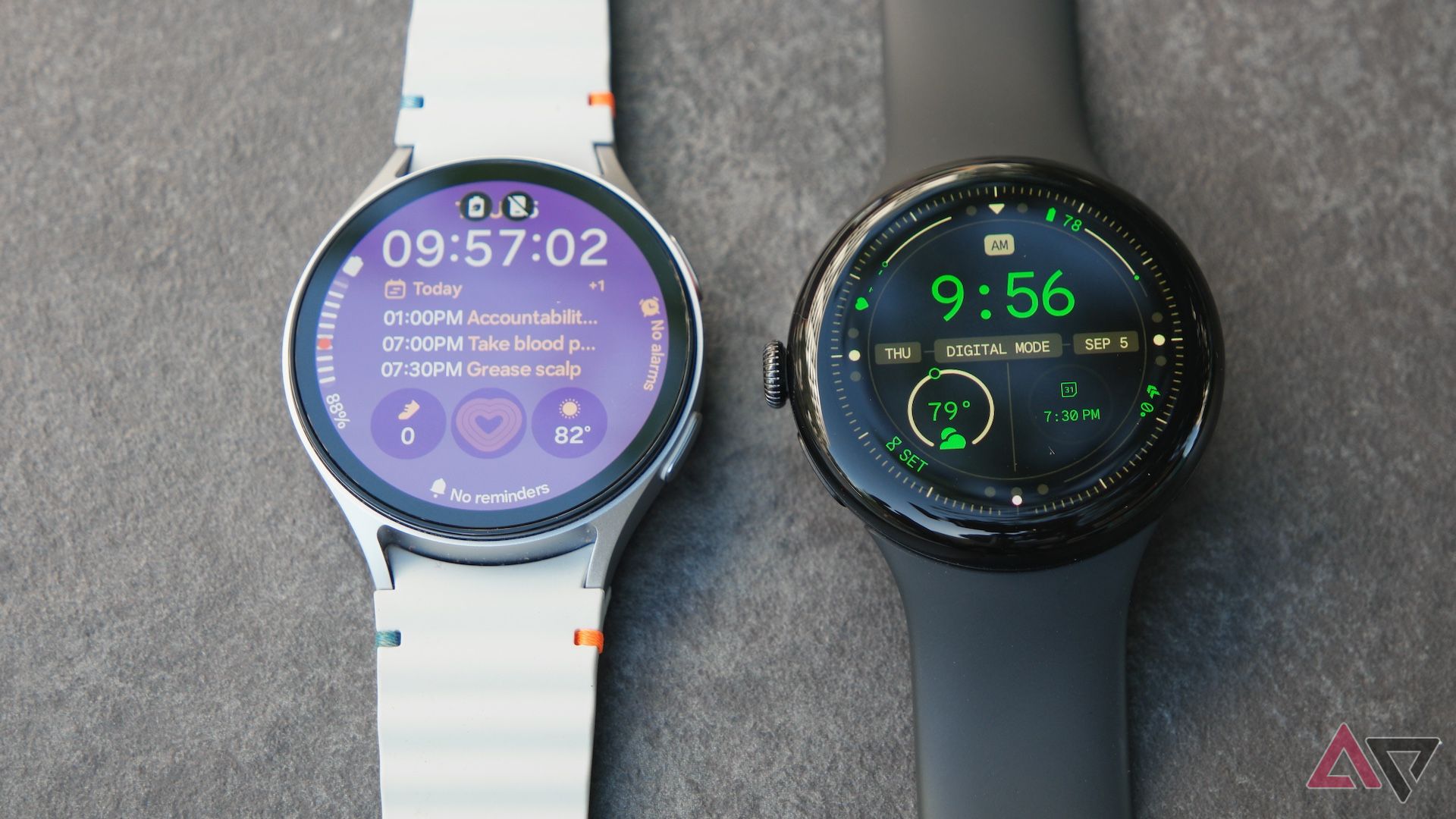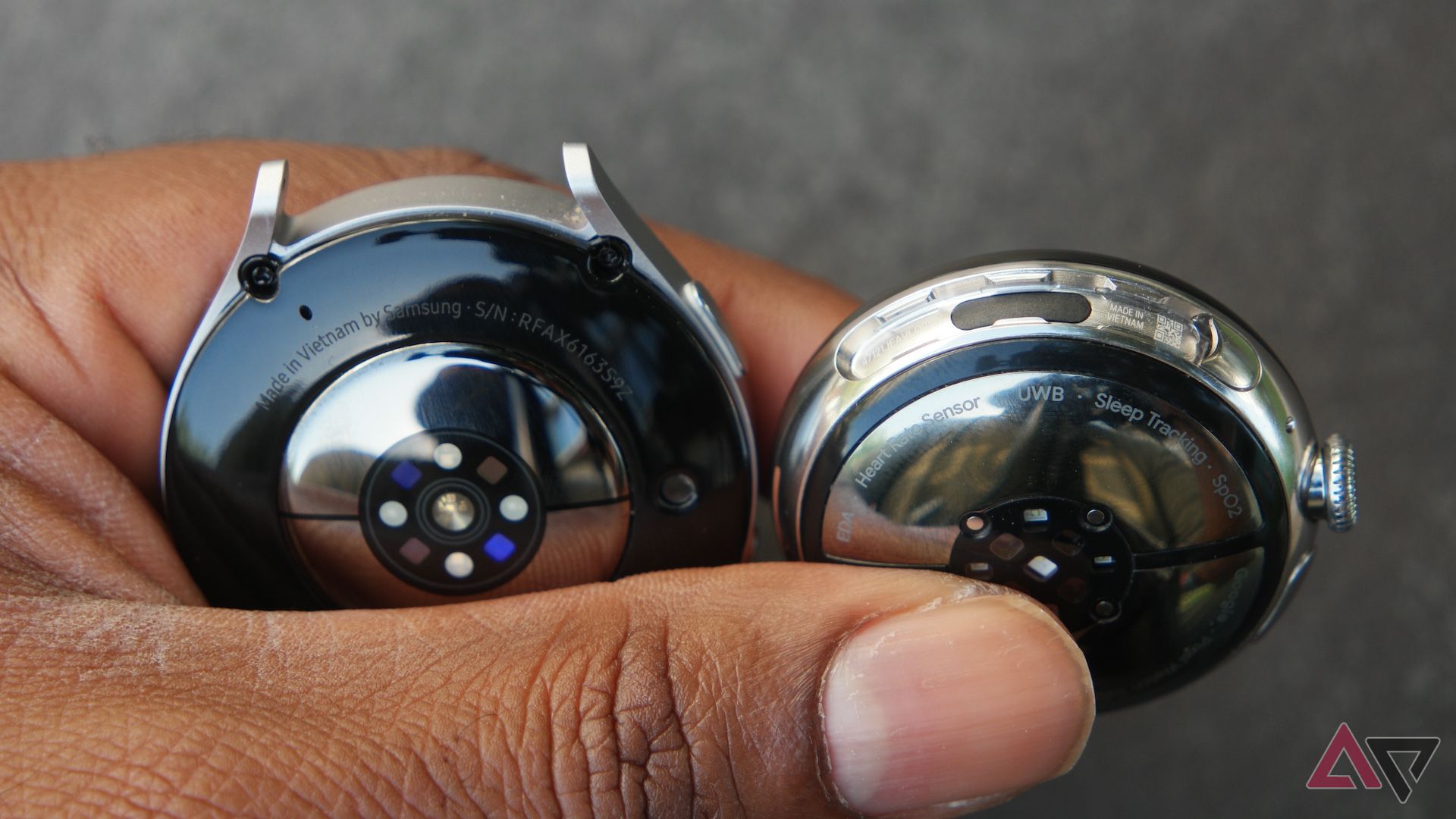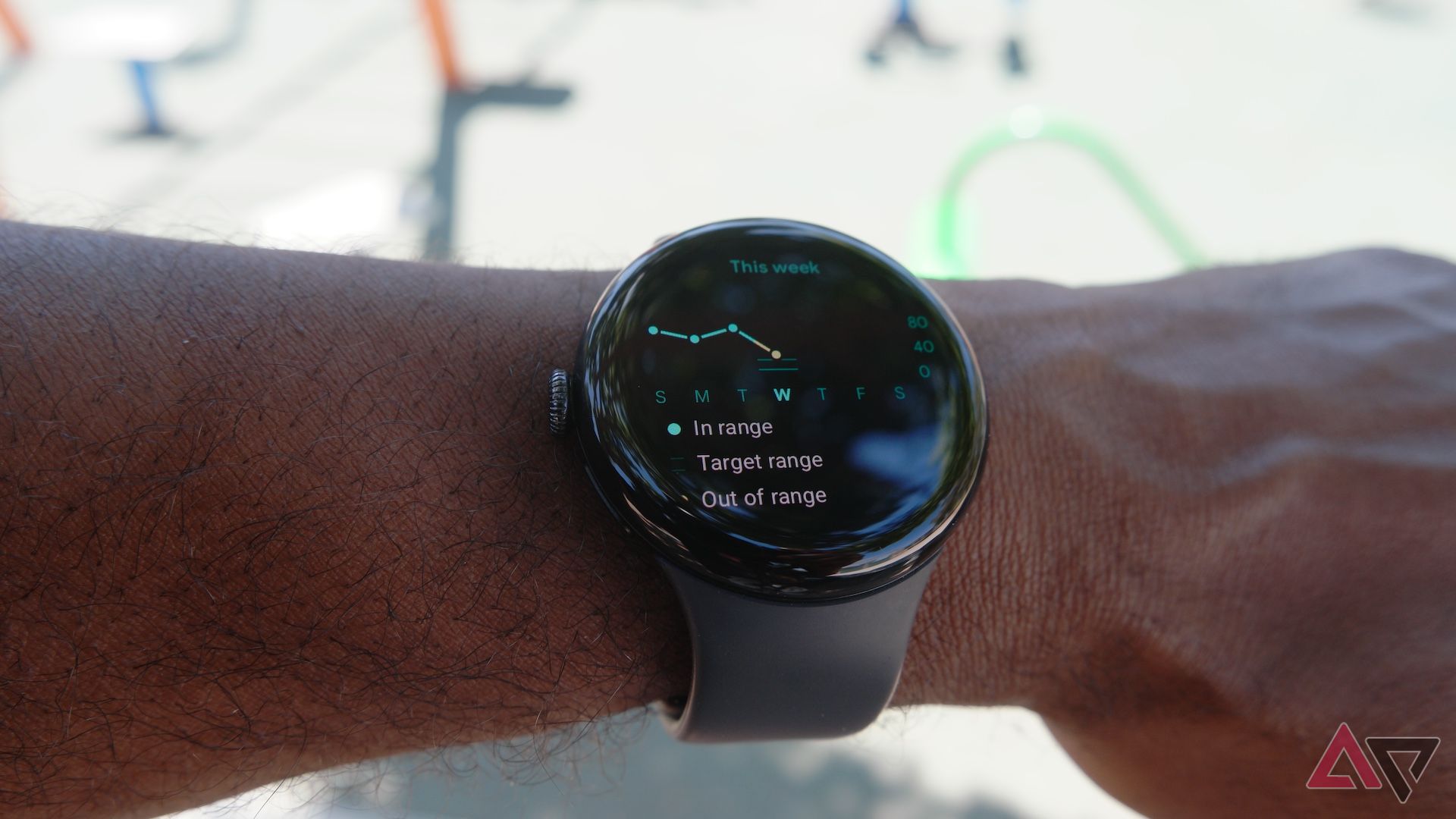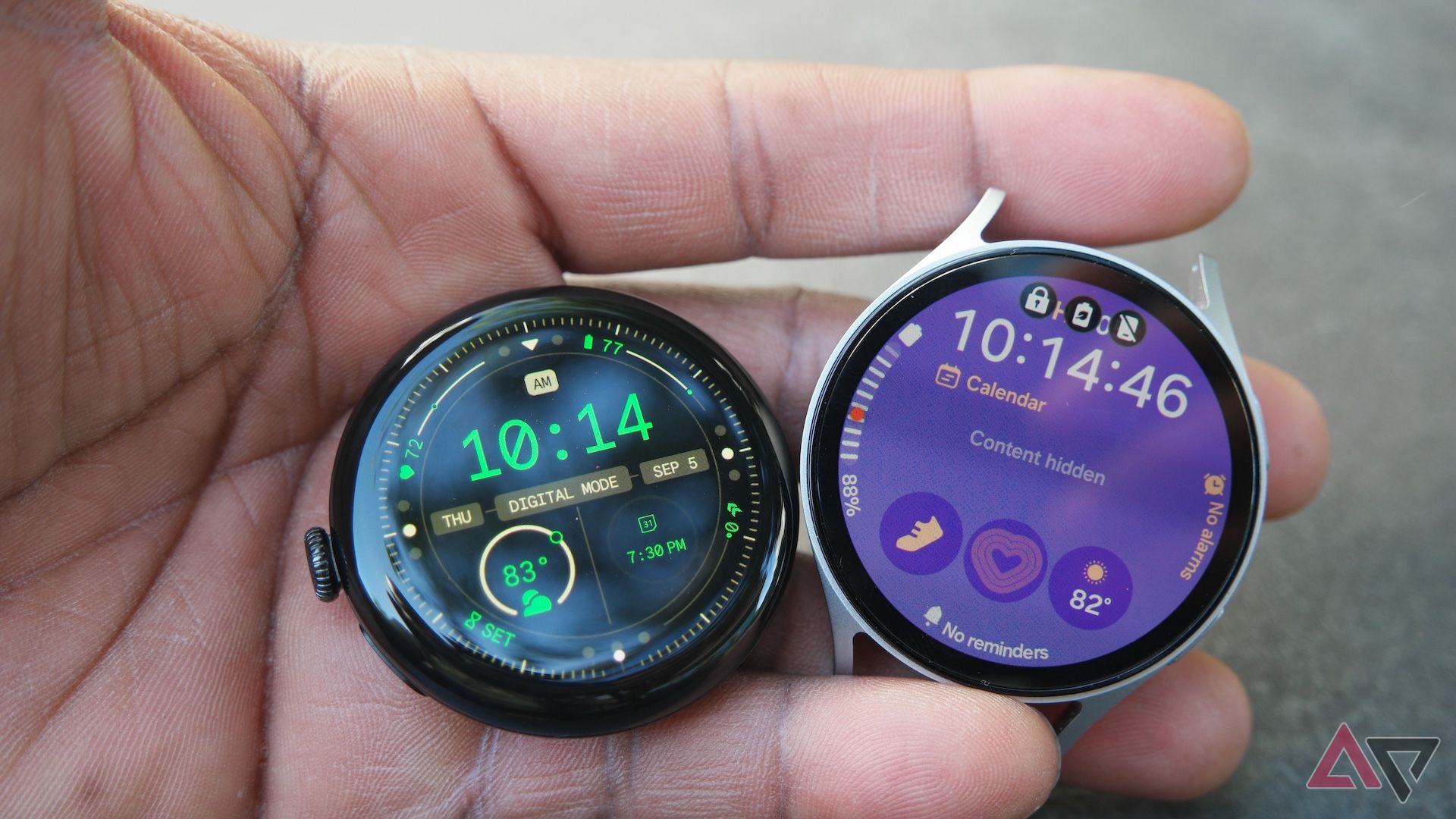-
Modern, sleek design
Google Pixel Watch 3
Google’s newest smartwatch brings several welcome improvements, including a larger 45mm variant, an upgraded display, and tons of software enhancements.
Pros- LTPO OLED display with up to a 60Hz refresh rate
- Solid performance
- Sleek design
Cons- Relatively expensive
- Proprietary band connector
-

Traditional look
Samsung Galaxy Watch 7
Samsung’s Galaxy Watch 7 builds upon an already impressive Galaxy Watch 6 with upgraded sensors, dual-frequency GPS, and a new processor.
Pros- Support for standard watch bands
- Ability to track over 100 activities and workouts
- More affordable than the Pixel Watch 3
Cons- Some health features are only available to Samsung phone owners
Google’s new Pixel Watch 3 is here, and it brings several software and tracking improvements to make it more enticing for Android owners. While it doesn’t have a lot of competition, Samsung Galaxy Watch 7 is one of the biggest rivals. Running on Wear OS 5, like the Pixel Watch 3, the Galaxy Watch 7 builds on its predecessor with an upgraded BioActive Sensor, larger battery, and better-performing GPS. So which of the two smartwatches is more suitable for you? Let’s find out.
Price, availability, and specs
The Pixel Watch 3 costs $350 for the 41mm Wi-Fi-only variant and $400 for the 45mm Wi-Fi-only variant. Both sizes are also available with cellular connectivity and cost $100 extra. In comparison, the Galaxy Watch 7’s 40mm Wi-Fi-only version is priced at $300, whereas the 44mm version is $330. And it’s only $50 extra for LTE connectivity for both sizes. So, you can save a decent chunk of change by opting for the Samsung smartwatch.
These smartwatches are widely available through the usual retailers, including Amazon, Best Buy, and the official company stores. The LTE variants are also available from all three major carriers.
Here’s a quick look at the raw specifications of both smartwatches.
Design and display
Distinct designs with OLED screens
Although the Pixel Watch 3 and the Galaxy Watch 7 have a circular watch face, their overall designs are pretty distinct. While the Galaxy Watch 7’s aluminum casing has visible lugs to accommodate the standard watch bands, Google has opted for a recessed lug design with a proprietary connector. So, no matter which band you use with the Pixel Watch 3, it’ll seamlessly connect and fully integrate into the watch’s design, which is not always the case with the Galaxy Watch 7. But that’s not bad, as the support for the standard watch bands gives Samsung smartwatch owners access to a much more comprehensive band range.
Moreover, Google uses domed glass atop the display, which wraps around the sides, giving the smartwatch a unique look, whereas the Galaxy Watch 7 has a more traditional flat glass display. However, Samsung uses sapphire crystal glass, which is said to be more scratch-resistant than the Gorilla Glass 5 on the Pixel Watch 3.
Among other differences, the Pixel Watch 3 has a slightly smaller 1.2-inch display on the 41mm and a 1.4-inch display on the 45mm. The Galaxy Watch 7, however, has 1.3-inch and 1.5-inch displays on the 40mm and 44mm models, respectively. Both smartwatches use
OLED panels capable of reaching up to 2,000 nits. That said, the Pixel Watch 3 has an LTPO panel that allows it to offer a variable refresh rate and the ability to dim the brightness to 1 nit for better efficiency.
Software and health & fitness
It’s Fitbit vs. Samsung Health
The Pixel Watch 3 and the Galaxy Watch 7 run on the same version of Wear OS. However, Samsung uses its One UI 6 Watch interface on top of the Wear OS 5. If you are coming from an older Samsung smartwatch, you’ll feel right at home. Thanks to Samsung’s years of experience building smartwatches, its software experience is quite refined. Although Google has no extra UI, it still includes features you won’t find on other Wear OS smartwatches. So you aren’t technically getting a stock experience, but this is the closest you’ll get.
There is a lot to like about the two smartwatches when it comes to activity and fitness tracking. While the Pixel Watch 3 can track up to 40 workout types, the Galaxy Watch 7 can track over 100. You can also create custom workout routines and understand your recovery. The Pixel Watch 3 and the Galaxy Watch 7 also have tons of sensors, including a heart-rate tracker, blood-oxygen sensor, and skin temperature sensor to keep an eye on your body while working out and in general.
Notably, the Samsung smartwatch offers all the fitness-related insights free of cost. In contrast, you’ll need the Fitbit Premium subscription to access some of those on the Pixel Watch 3. These Fitbit Premium features include a breakdown of sleep scores, a monthly sleep profile, guided meditations, stress management scores and details, and advanced running insights.
Both smartwatches also have several features that only work with smartphones from their manufacturers. While Google’s locked-in features include functions like unlocking compatible Pixel phones, phone camera control, and Call Assist. Samsung goes deeper by offering health-related features, such as ECG (AFib) measurements, irregular HR monitoring, and sleep apnea detection on its Samsung Health Monitor app, which is only accessible on Samsung phones.
Performance and battery life
Responsive and snappy all around
While Google has selected the Qualcomm SW5100 chip to power the Pixel Watch 3 (the same as the Pixel Watch 2), Samsung has included its Exynos W1000 in the Galaxy Watch 7, an upgrade over the Galaxy Watch 6. Both are pretty capable chips and help deliver a quick, responsive performance. Additionally, you get 2GB of RAM, 32GB of storage, dual-band Wi-Fi, NFC, and optional LTE connectivity on the smartwatches.
GPS is the one aspect in which the Galaxy Watch 7 seemingly has an advantage over the Google smartwatch. Samsung has included dual-frequency GPS in the Watch 7. This should allow the smartwatch to offer better location accuracy and quicker location locking. But as we found in our testing, it’s not always the case. The Pixel Watch 3, on the other hand, uses single-frequency GPS.
Both smartwatches have similar-sized batteries. While the smartwatches’ smaller sizes can last 24 hours on a single charge, the bigger models can go slightly beyond. But it’ll be a daily charging chore for most users.
Which should you buy?
Undoubtedly, the Pixel Watch 3 and the Galaxy Watch 7 are very capable smartwatches that will keep most people happy. While the choice between them mostly depends on which smartphone you own, you also have to consider your budget. If money isn’t an issue, and you own a non-Samsung phone, the Pixel Watch 3 is a solid choice. Sure, it has some exclusives for Pixel smartphone owners, but it doesn’t restrict any health or fitness features for non-Pixel users. However, some of its deeper fitness-related insights require a Fitbit Premium subscription.

Editor’s choice
Google Pixel Watch 3
Sleek design and solid performance
There is much to like about the Pixel Watch 3, from its sleek design to impressive health and fitness tracking capabilities. There is also a larger size that many folks were missing in the previous iterations.
However, if you own a Samsung phone, choosing the Galaxy Watch 7 is a no-brainer. You’ll have access to all features, it costs less, and a subscription is not required to access activity-related insights. The watch is also FDA-cleared for sleep apnea detection. The Galaxy Watch 7 is great if you don’t own a Samsung smartphone but have a tighter budget. You may miss out on a few features, but there is plenty more to fulfill your smartwatch usage needs.

Runner-up
Samsung Galaxy Watch 7
Best for Samsung owners
The Galaxy Watch 7 is an easy choice for Samsung smartphone users and any Android users who want to save a bit of money. It has refined software and solid activity and health-tracking capabilities.




